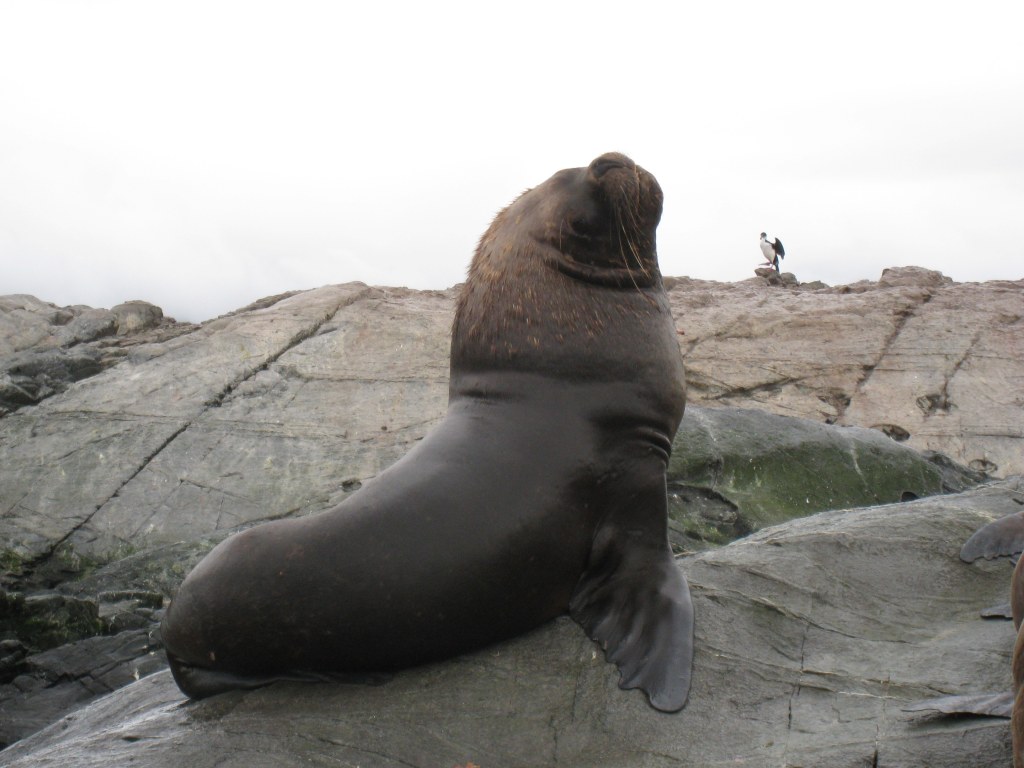Unleash The Power Of The Majestic Bull South American Sea Lion: A Captivating CTA Journey!
Bull South American Sea Lion: A Majestic Creature of the Ocean
Introduction
Good People,
2 Picture Gallery: Unleash The Power Of The Majestic Bull South American Sea Lion: A Captivating CTA Journey!


Welcome to this informative article dedicated to the fascinating bull South American sea lion. As avid Lions Enthusiasts, we are thrilled to provide you with in-depth knowledge about this majestic creature. The South American sea lion, known scientifically as Otaria flavescens, is a unique marine mammal that inhabits the coastal regions of South America. In this article, we will explore the characteristics, habitat, behavior, and conservation status of the bull South American sea lion. So, let us dive deep into the captivating world of these magnificent creatures.
Characteristics of the Bull South American Sea Lion

Image Source: wikimedia.org
🔍 The bull South American sea lion is the largest member of the Otariidae family, with males reaching an average length of 8 feet and weighing up to 770 pounds. They possess a robust and muscular body, with a distinctive mane around their neck and shoulders.
🔍 The coloration of the bull South American sea lion varies from light brown to gray, with some individuals displaying a darker shade. Their fur is dense and water-repellent, allowing them to thrive in the oceanic environment.

Image Source: wikimedia.org
🔍 These impressive creatures have a set of sharp teeth, which they use for hunting prey and defending their territory. Their canine teeth, known as canines, are particularly prominent and contribute to their fierce appearance.
🔍 Bull South American sea lions exhibit sexual dimorphism, with males being significantly larger than females. Their size and physical attributes play a vital role in asserting dominance and attracting mates.
🔍 The lifespan of bull South American sea lions ranges from 20 to 25 years in the wild, although some individuals have been known to live longer under favorable conditions.
🔍 These marine mammals have excellent swimming abilities, with the capability to reach speeds of up to 25 miles per hour. Their streamlined bodies and powerful flippers enable them to navigate through the water with ease.
🔍 Bull South American sea lions are highly intelligent creatures, exhibiting complex social structures and communication methods. Their vocalizations consist of various barks, roars, and growls, which serve as a means of establishing dominance and attracting potential mates.
Habitat of the Bull South American Sea Lion
🔍 Bull South American sea lions primarily inhabit the coasts of South America, from Peru to Argentina, including the Falkland Islands. They are commonly found on rocky shorelines, sandy beaches, and inshore islands.
🔍 These sea lions prefer areas with abundant food sources, such as fish, squid, and crustaceans. Their agile swimming skills allow them to venture into deeper waters in search of prey.
🔍 The bull South American sea lion is well-adapted to both marine and terrestrial environments. They spend a significant amount of time on land, forming large colonies known as rookeries, where they breed, rest, and molt.
🔍 The rookeries provide protection against predators and harsh weather conditions. They are often located in secluded areas, such as remote islands or inaccessible coastal regions.
🔍 Due to their coastal habitat, these sea lions are exposed to the impacts of human activities, such as overfishing, pollution, and habitat destruction. Conservation efforts are crucial to ensure their survival and the preservation of their natural habitat.
Behavior of the Bull South American Sea Lion
🔍 Bull South American sea lions are highly social animals, forming elaborate hierarchies within their colonies. Dominant males establish territories and defend them from intruders, while females and juveniles live in close-knit family groups.
🔍 These sea lions exhibit an impressive breeding behavior known as a lek system. Dominant males gather a harem of females and fiercely compete with rivals to maintain their reproductive success.
🔍 The breeding season for bull South American sea lions usually occurs between November and January. During this time, males engage in intense battles, utilizing their impressive size and strength to assert dominance.
🔍 After a successful breeding season, females give birth to a single pup, which they nurse for approximately one year. The maternal bond between the mother and pup is strong, with the female providing care and protection until the young sea lion becomes independent.
🔍 Bull South American sea lions are highly opportunistic predators, feeding on a variety of marine species. Their diet mainly consists of fish, such as anchovies, sardines, and hake, but they also consume squid and crustaceans when available.
🔍 These sea lions are known for their impressive diving abilities, reaching depths of up to 300 feet in search of prey. They can hold their breath for extended periods, allowing them to forage efficiently in the depths of the ocean.
🔍 The bull South American sea lion plays a crucial role in maintaining the balance of marine ecosystems, as they are both predator and prey. Their presence in coastal areas indicates a healthy and thriving marine environment.
Conservation Status of the Bull South American Sea Lion
🔍 The bull South American sea lion is currently listed as a species of least concern by the International Union for Conservation of Nature (IUCN). However, certain threats pose risks to their population.
🔍 Overfishing and habitat degradation are significant concerns for the survival of these sea lions. The depletion of fish stocks due to commercial fishing practices can lead to food scarcity, impacting the reproductive success and overall health of the species.
🔍 Pollution, including oil spills and plastic debris, also poses a threat to the bull South American sea lion and other marine organisms. Ingestion of plastic can cause internal injuries and lead to starvation.
🔍 Climate change and rising sea temperatures may affect the availability of prey species, disrupting the delicate balance of the marine ecosystem and indirectly impacting the sea lion population.
🔍 Conservation efforts are essential to protect the bull South American sea lion and its habitat. These include the establishment of marine protected areas, sustainable fishing practices, and public awareness campaigns to promote responsible tourism and reduce pollution.
🔍 By implementing these measures, we can ensure the long-term survival and well-being of these magnificent creatures for future generations to appreciate and cherish.
Frequently Asked Questions about Bull South American Sea Lions
Q1: What is the average size of a bull South American sea lion?
A1: The average size of a bull South American sea lion is around 8 feet in length and can weigh up to 770 pounds.
Q2: Where can bull South American sea lions be found?
A2: Bull South American sea lions primarily inhabit the coasts of South America, from Peru to Argentina, including the Falkland Islands.
Q3: What do bull South American sea lions eat?
A3: Bull South American sea lions mainly feed on fish, such as anchovies, sardines, and hake, but they also consume squid and crustaceans when available.
Q4: How long do bull South American sea lions live?
A4: The average lifespan of a bull South American sea lion is around 20 to 25 years in the wild.
Q5: What are the major threats to the bull South American sea lion?
A5: The major threats to the bull South American sea lion include overfishing, habitat degradation, pollution, and climate change.
Conclusion
In conclusion, the bull South American sea lion is a remarkable creature that thrives in the coastal regions of South America. Its impressive size, intelligence, and social behavior make it a captivating subject of study and admiration. However, the survival of these sea lions is at risk due to various human-induced factors.
It is crucial for us, as responsible stewards of the environment, to take action towards the conservation of the bull South American sea lion. By raising awareness, supporting sustainable practices, and advocating for the protection of their habitat, we can ensure the long-term survival of these magnificent creatures.
Let us join hands and work towards a future where the bull South American sea lion, and all marine species, can thrive in harmony with our planet’s delicate ecosystems.
Final Remarks
🔍 The information provided in this article is based on extensive research and available scientific literature. We strive to present accurate and up-to-date information regarding the bull South American sea lion.
🔍 However, it is important to note that scientific knowledge is constantly evolving, and new discoveries may influence our understanding of this species. We encourage readers to explore additional sources and contribute to the ongoing research and conservation efforts.
🔍 The images used in this article are for illustrative purposes only and do not represent specific individuals or locations. Credits to the respective photographers and organizations for capturing the beauty of the bull South American sea lion.
🔍 Remember, we all have a responsibility to protect our oceans and the incredible creatures that call them home. Together, we can make a difference and ensure a sustainable future for the bull South American sea lion and all marine life.
This post topic: Lions



